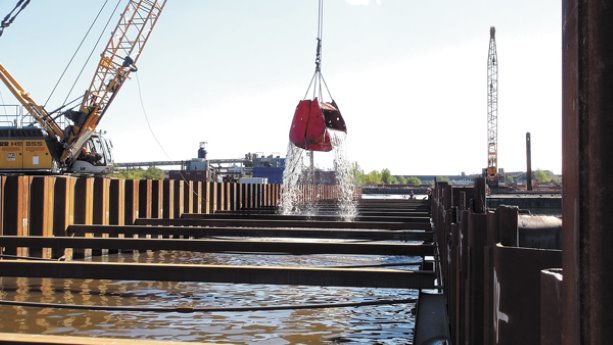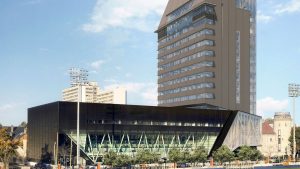Sometimes the best designs are the most straightforward.
That’s the plan for the Randle Reef cleanup at Hamilton Harbour, where a gigantic steel box — an engineered containment facility (ECF) — designed to contain legacy contaminated sediment nears completion.
The $140-million Randle Reef Contaminated Sediment Remediation project will remediate approximately 695,000 cubic metres of contaminated sediments, with costs shared equally by Canada, Ontario and the local community, which includes the City of Hamilton, City of Burlington, Halton Region, U.S. Steel Canada and the Hamilton Port Authority.
U.S. Steel is meeting its $14-million commitment to the project by supplying $12 million worth of steel, including 10,000 tonnes of hot rolled steel sheets and 700 tonnes of other steel.
In December 2012, Bermingham Foundation Solutions drove eight steel test pylons into the lakebed to help set the parameters of the ECF.
Those piles have since been removed prior to awarding the stage one construction contracts in mid-2015.
These include:
• the contract to build the ECF, awarded to McNally Construction Inc.
• the contract to rebuild an adjacent harbour wall at the Hamilton Port Authority’s Pier 15, awarded to Dean Construction Co. Ltd.
• the contract for provision of civil engineering services for supervision of stage one construction, awarded to Riggs Engineering Ltd.
Reconstruction of Pier 15 was a necessary part of the construction of the ECF, says Roger Santiago, sediment remediation program co-ordinator with Environment and Climate Change Canada.
"We were concerned that dredging in front of the wall of the pier could lead to a potential failure if we excavated adjacent sediment," he says.
"We built a steel wall about a metre out from the original timber wall, then took out the old infrastructure and built new supporting features and anchor blocks. That work was completed in spring 2016."
Construction of the ECF began shortly after. To date, all of the exterior containment walls of the ECF have been driven into place up to 24 metres down to form the perimeter of the box, which covers 6.2 hectares, the equivalent of seven Canadian football fields.
"Most of the exterior sheet steel went in without the use of an impact hammer, but a few sheets needed a little extra assistance to go the final way," says Santiago. "The interior wall only needed to be driven three metres into native clay, which is sealed by the exterior wall."
Both inner and outer sheet steel walls are being sealed to form an impermeable barrier. The space between interior and exterior walls will then be dredged and the sediment placed inside the ECF.
"Granular material is being placed between the walls and a further backfill with rock provides additional structural stability for the ECF," says Santiago.
Construction of the open box is slated to conclude by December 2017.
Subsequent dredging between Pier 15 and the ECF and adjacent areas will remove additional contaminated sediment, which will also be placed inside the ECF. The material will then be dewatered and the treated water will be reintroduced into the lake.
The work incidentally creates a newly dredged and remediated shipping lane in Hamilton Harbour.
The completion of the project, scheduled for 2022, will involve the placement of a multi-layered environmental cap on top of the ECF to protect the sediment and prevent infiltration of precipitation.
The cap will include aggregates, geo-textile, geo-grid, wick drains and surface materials, with asphalt and/or concrete on top. This will also provide a foundation for future port structures.
The Hamilton Port Authority will ultimately take on the responsibility for monitoring the ECF, which has a design life of 200 years.
Santiago has worked on the file since project inception in 1994.
"I’m glad to be around to see the project to completion," he says. "It’s a great collaboration between government, industry and the Hamilton Port Authority and a model for future environmental remediation projects."





Recent Comments
comments for this post are closed